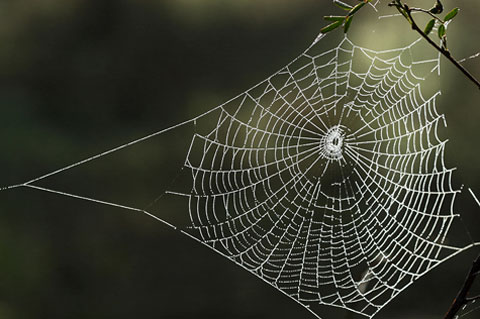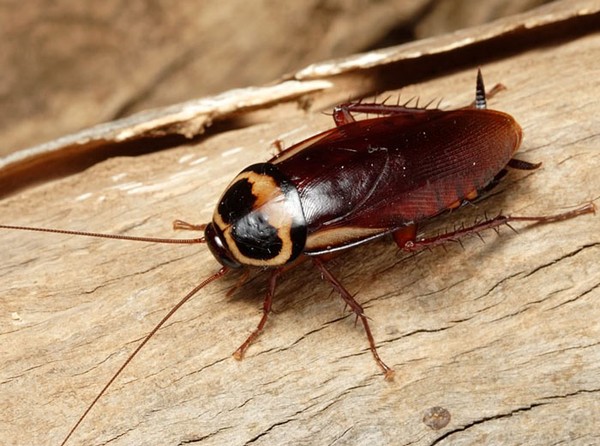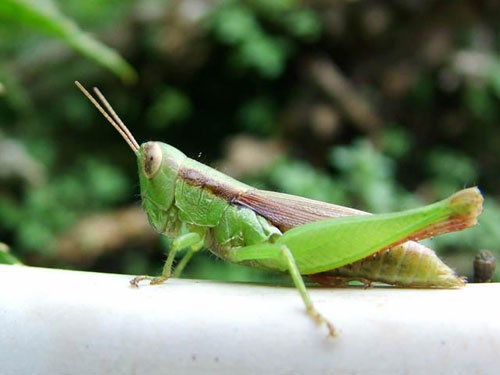The incredible abilities of insects
In the mysterious natural world, some insects are likened to true warriors because they have superior abilities that deserve to be recorded in 'military textbooks'. Here are the special skills of some insects that may surprise you.
Surprised by the superhuman abilities of insects
1. Spider - Bulletproof

Few people know the Kevlar bulletproof vest used in special units is the most durable armor man ever made. But the silk thread released by the spider is three times more durable than the upper armor. Moreover, it is surprisingly light. A spider silk wrapped a circle around the earth just slightly lighter than a soap cake. Some scientists have sought to create spider silk in the laboratory but so far have not achieved satisfactory results.
2. Cockroaches - Anti-radiation

Cockroaches have appeared on the earth more than 300 million years ago. If nuclear war happens, one thing is certain that they are unharmed. Unlike humans, cockroach's radiation tolerance is remarkable. Once every two weeks of molting, this process lasts 2 days. During molting, the cells divide and only when divided, new cells are vulnerable to radiation exposure. Therefore a large nuclear explosion can wipe out humanity, but up to ¾ of cockroaches can survive if they are not during molting at the time.
3. Grasshopper - The 'Fortress' flies

Scientists have not yet explained why the locust can abruptly follow a chaotic army , looking giant like the 1st Air Force carrying American presidents. One theory is that grasshoppers are able to sense changes in quantity. When the grasshopper herd moves, the other animals automatically join the lineup. Stephen Simpson, of the University of Sydney, said grasshoppers feel more secure in the herd than they are separate because they have only two choices or find bait or flock.
4. Fireflies - Data encryption

The bioluminescence ability of fireflies is not merely a deadly trap. More strangely, the light emitted from the darkness is an encoded language, a kind of Mo-signal. Flashes of light with different short and long frequencies contain different messages, which can be an invitation to a partner, can also be a warning signal to an enemy or a trap to lure prey. Deciphering fireflies' light signals is very complicated. Until now, researchers have yet to explain whether there are other messages encoded in fireflies' light signals.
5. Bees - Create tornadoes

Flying by creating a storm of bees is probably the skill that a Ninja doesn't expect much. It is not until 2006 that we can explain why a bee with tiny wings can create thrust to lift the entire body weight into the air. Unlike an airplane wing designed to create a jet to lift the body of the helicopter, the wings of the bee beating from the back to the front act as a helicopter's propeller. When flapping its wings it creates a tornado like a small storm in the air. The eye has a lower pressure than the surrounding air, thus keeping tornadoes above the wing and allowing the bee to fly.
6. Cicada - Avoid enemies

Perhaps in nature, there are no intelligent species like periodic cicadas. The extraordinary ability to calculate 'arithmetic' helps these cicadas avoid ' encountering' their enemies. They have a terrestrial life cycle of 13 years or 17 years, while predators such as hornets and mantis have a 3 or 5 year lifespan. These lifecycle never overlap because 13 and 17 are prime numbers. So cicadas and their natural enemies never appear on the ground at the same time.
7. Scorpion - Warrior spirit

Not only the poisoned tail, but the whole scorpion body is also an armor. In the dark, they can frighten any enemy by glowing themselves.
8. Beetle: locating the moon light
Because the moon is much dimmer than the sun, no one is sure whether animals can use polarized moonlight to locate.

Now Marie Dacke of Lund University, Sweden and her team point out that the dung beetle Scarabaeus Zambesianus uses polarized eyesight. They often find the dung, squeeze the waste into a ball and roll it. After walking around safely, they buried the feces and ate it on the ground.
The beetle leaves the pile in a straight line because they need to escape quickly when other dung beetles take over the orbs being transported. According to the team, the beetle uses polarized light from the moon, not the moon itself. Some cloudy sky also provides enough light for positioning.
When the experts put a polarizing filter above the dung beetle to change the polarization direction by 90 degrees, they saw that they turned a right angle. On moonless nights or too many clouds, dung bugs cannot move in a straight line. The team found special receptors in their eyes. These receptors detect polarized moon light that is 1 million times dimmer than sunlight.
- The incredible and incredible abilities of young children
- The unbelievable 'transcendental' abilities of insects
- The incredible record of insects
- The incredible abilities of aquatic creatures
- The special abilities of human beings make science 'respectable'.
- Lessons from insect masters
- Insect-eating insects like to eat
- 10 animals have strange abilities
- Both psychic and telepathic abilities exist in every human being
- Set of brilliant photos showing off
- People with strange abilities due to ... genetic errors
- Marvel at 8 incredible facts that seem like a myth
 Why do potatoes have eyes?
Why do potatoes have eyes? 'Tragedy' the world's largest carnivorous life: Death becomes ... public toilet
'Tragedy' the world's largest carnivorous life: Death becomes ... public toilet Tomatoes were once considered 'poisonous' for 200 years
Tomatoes were once considered 'poisonous' for 200 years Detecting microscopic parasites on human face
Detecting microscopic parasites on human face